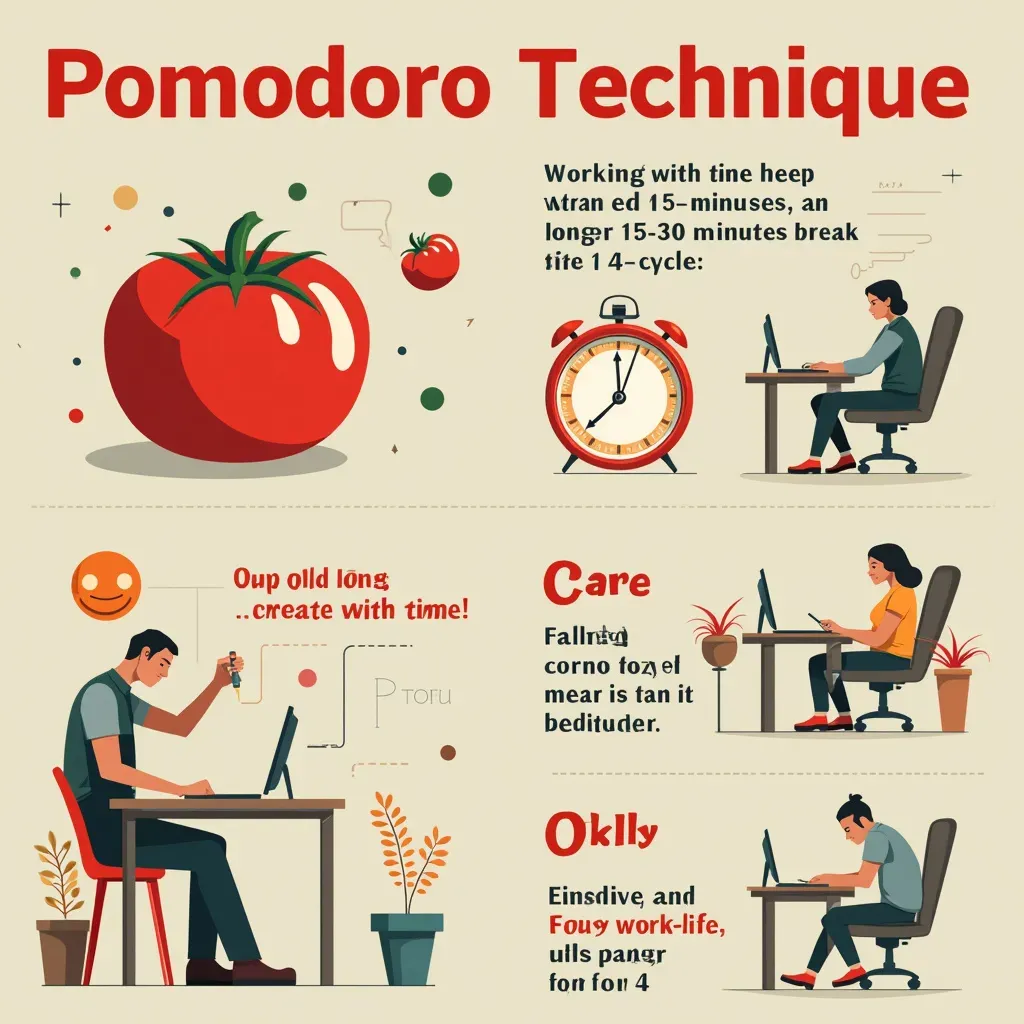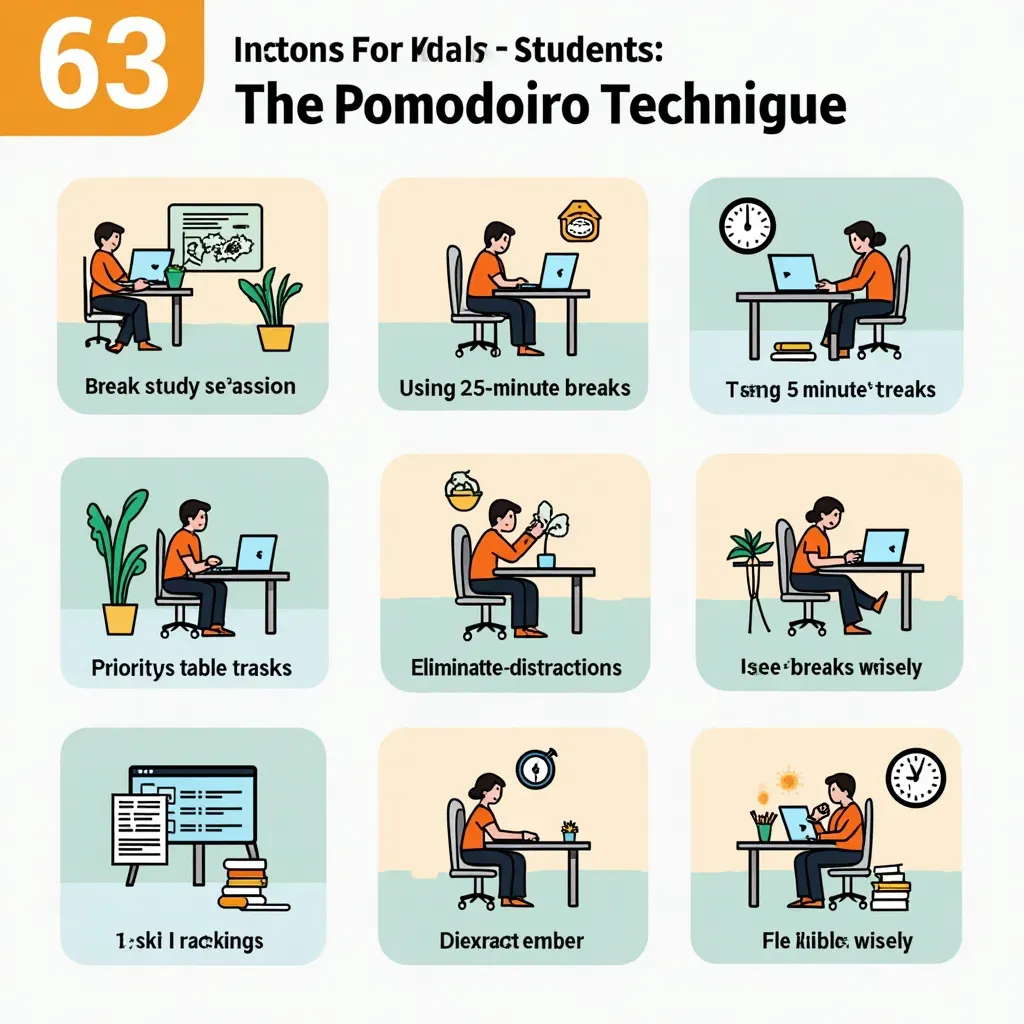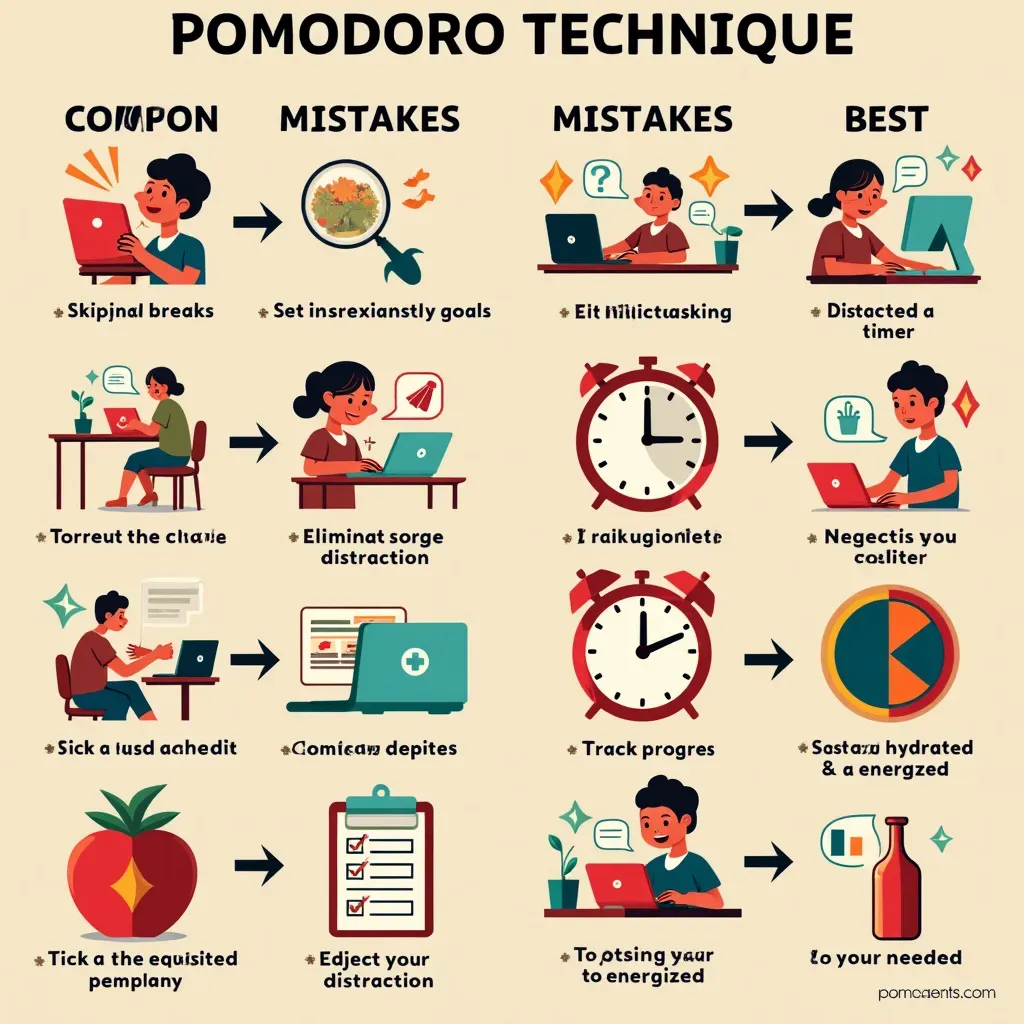Mastering the Pomodoro Technique: Boost Your Productivity with This Simple Time Management Method
Discover how the Pomodoro Technique can enhance your productivity with this comprehensive guide. Learn about its benefits, applications, and best practices.

Mastering the Pomodoro Technique: Boost Your Productivity with This Simple Time Management Method
The Pomodoro Technique is a popular time management method that has been gaining traction among students, professionals, and anyone looking to boost their productivity. Named after the tomato-shaped kitchen timer that its inventor, Francesco Cirillo, used during university, the Pomodoro Technique breaks work into intervals, traditionally 25 minutes in length, separated by short breaks. In this article, we will delve into the intricacies of the Pomodoro Technique, explore its benefits, and provide practical tips on how to incorporate it into your daily routine. Whether you are new to this method or looking to optimize your current use, this comprehensive guide will help you master the Pomodoro Technique.

Introduction to the Pomodoro Technique
The Pomodoro Technique is a time management method that was developed by Francesco Cirillo in the late 1980s. The technique is named after the tomato-shaped kitchen timer that Cirillo used during university to manage his study sessions. The fundamental idea is simple: work in focused intervals of 25 minutes (known as Pomodoros), followed by a short 5-minute break. After completing four Pomodoros, take a longer break of 15-30 minutes. This cyclical process helps maintain concentration and productivity while preventing burnout.
The Pomodoro Technique is rooted in several core principles:
- Work with time, not against it: By breaking down work into manageable intervals, the Pomodoro Technique encourages a partnership with time rather than a battle against it.
- Eliminate burnout: Regular breaks prevent mental fatigue, allowing you to maintain high levels of productivity over longer periods.
- Enhance focus: Knowing that you have a limited amount of time to complete a task helps you stay focused and avoid distractions.
- Improve work-life balance: The structured nature of the Pomodoro Technique ensures that you make time for both work and relaxation.
Using the Pomodoro Technique is straightforward:
- Choose a task you want to work on.
- Set a timer for 25 minutes (one Pomodoro).
- Work on the task until the timer rings.
- Take a 5-minute break.
- After completing four Pomodoros, take a longer break of 15-30 minutes.
While the traditional Pomodoro interval is 25 minutes, you can customize the timing to suit your needs. For example, some people prefer longer intervals of 45 minutes with 10-minute breaks, while others find that shorter intervals of 15 minutes work best for them. The key is to find a rhythm that works for you and stick with it.

Benefits and Psychology Behind the Pomodoro Technique
The Pomodoro Technique offers numerous benefits, many of which are rooted in psychology and behavioral science. Understanding these benefits can help you make the most of this powerful time management method.
Benefits of the Pomodoro Technique
- Enhanced Focus: By working in short, focused intervals, the Pomodoro Technique helps minimize distractions and improve concentration. The timer creates a sense of urgency, encouraging you to stay on task.
- Increased Productivity: Regular breaks prevent burnout and keep your mind fresh, allowing you to maintain high levels of productivity throughout the day.
- Better Time Management: The Pomodoro Technique promotes efficient use of time by breaking tasks into manageable chunks. This makes it easier to plan and prioritize your work.
- Reduced Procrastination: The structured nature of the Pomodoro Technique helps combat procrastination by providing clear guidelines for work and rest periods.
- Improved Work-Life Balance: By incorporating regular breaks and longer rest periods, the Pomodoro Technique ensures that you make time for both work and relaxation, reducing the risk of burnout.
Psychology Behind the Pomodoro Technique
The success of the Pomodoro Technique can be attributed to several psychological principles:
- Chunking: Breaking tasks into smaller, manageable chunks makes them less overwhelming and easier to tackle. This concept, known as chunking, is a well-established principle in cognitive psychology.
- Attention Restoration: Research shows that taking regular breaks can help restore attention and improve cognitive function. The Pomodoro Technique leverages this principle by incorporating short breaks into the work process.
- Commitment and Consistency: The Pomodoro Technique encourages a commitment to focused work intervals and regular breaks. This consistency helps build productive habits and enhances time management skills.
- Reward System: The anticipation of a break serves as a reward for completing a Pomodoro, reinforcing positive behavior and motivating continued effort.
- Flow State: The Pomodoro Technique promotes the attainment of a flow state, where individuals experience heightened focus and immersion in their work. This state of optimal performance is characterized by deep concentration and a sense of satisfaction.
Understanding the benefits and psychological principles behind the Pomodoro Technique can help you harness its full potential. By incorporating this method into your daily routine, you can boost your productivity, improve time management, and maintain a healthy work-life balance.

Practical Application and Customization
The Pomodoro Technique is highly versatile and can be adapted to suit various needs and preferences. Whether you're a student, a professional, or someone looking to improve time management, this technique can be tailored to fit your lifestyle.
How to Use the Pomodoro Technique for Students
Students can greatly benefit from the Pomodoro Technique, especially when it comes to studying and completing assignments. Here are some tips for students:
- Break Down Study Sessions: Use Pomodoros to break down study sessions into manageable intervals. For example, study for 25 minutes, take a 5-minute break, and then repeat. This approach can help improve focus and retention.
- Prioritize Tasks: At the beginning of each study session, prioritize tasks and set clear goals for each Pomodoro. This ensures that you make the most of your study time.
- Eliminate Distractions: Find a quiet study environment and eliminate distractions. Turn off notifications on your phone and use apps or browser extensions to block distracting websites during Pomodoros.
- Use Breaks Wisely: Use your breaks to relax and recharge. Stretch, take a walk, or do a quick mindfulness exercise to clear your mind before the next Pomodoro.
- Track Progress: Keep track of completed Pomodoros and tasks. This can help you monitor your progress and stay motivated.
Customizing the Pomodoro Technique
While the traditional Pomodoro interval is 25 minutes, you can customize the timing to suit your needs. Here are some customization tips:
- Adjust Interval Lengths: Experiment with different interval lengths to find what works best for you. Some people prefer longer intervals of 45 minutes with 10-minute breaks, while others find that shorter intervals of 15 minutes work best for them.
- Flexible Breaks: Customize your break times based on your personal preferences and the nature of your work. For example, you may need longer breaks if your tasks are mentally demanding.
- Task-Specific Pomodoros: Adapt the Pomodoro Technique to different types of tasks. For example, use shorter Pomodoros for tasks that require intense focus and longer Pomodoros for tasks that involve creative thinking or problem-solving.
- Combine Techniques: Combine the Pomodoro Technique with other productivity methods, such as time blocking or the Eisenhower Matrix, to create a comprehensive time management system.
By customizing the Pomodoro Technique to fit your needs, you can maximize its effectiveness and make it a valuable tool in your productivity arsenal.

Common Mistakes and Best Practices
While the Pomodoro Technique is a simple and effective time management method, it's not uncommon for people to make mistakes when implementing it. Understanding these common pitfalls can help you avoid them and make the most of the technique.
Common Mistakes People Make When Using the Pomodoro Technique
- Skipping Breaks: One of the most common mistakes is skipping breaks. Breaks are essential for maintaining focus and preventing burnout. Ensure that you take short breaks after each Pomodoro and longer breaks after completing four Pomodoros.
- Setting Unrealistic Goals: Setting unrealistic goals for each Pomodoro can lead to frustration and decreased productivity. Make sure your goals are achievable within the 25-minute interval.
- Disregarding the Timer: Ignoring the timer and continuing to work past the Pomodoro interval can disrupt the rhythm of the technique. Stick to the timer and take breaks as scheduled.
- Multitasking: Multitasking during a Pomodoro can reduce focus and efficiency. Focus on one task at a time to maximize productivity.
- Neglecting to Plan: Failing to plan your tasks and Pomodoros can lead to disorganization and decreased productivity. Take a few minutes at the beginning of each session to plan and prioritize your tasks.
Best Practices for the Pomodoro Technique
- Stick to the Schedule: Adhere to the Pomodoro schedule and take breaks as planned. Consistency is key to maintaining focus and preventing burnout.
- Use a Timer: Use a timer to keep track of your Pomodoros and breaks. There are many Pomodoro apps and online timers available that can help you stay on track.
- Eliminate Distractions: Create a distraction-free environment during Pomodoros. Turn off notifications, close unnecessary tabs, and let others know that you are in a focused work session.
- Track Your Progress: Keep a record of your completed Pomodoros and tasks. This can help you monitor your progress and identify areas for improvement.
- Adjust as Needed: Be flexible and adjust the Pomodoro Technique to suit your needs. Experiment with different interval lengths and break times to find what works best for you.
- Stay Hydrated and Energized: Take care of your physical well-being by staying hydrated and eating healthy snacks during breaks. This can help maintain your energy levels and focus.
By avoiding common mistakes and following best practices, you can make the most of the Pomodoro Technique and achieve greater productivity and focus.




